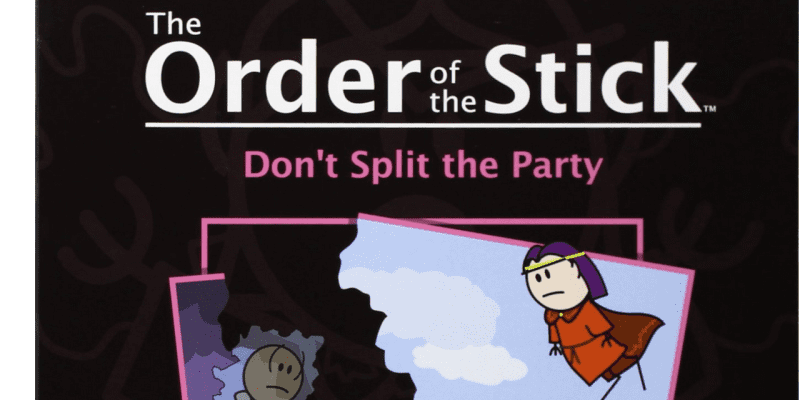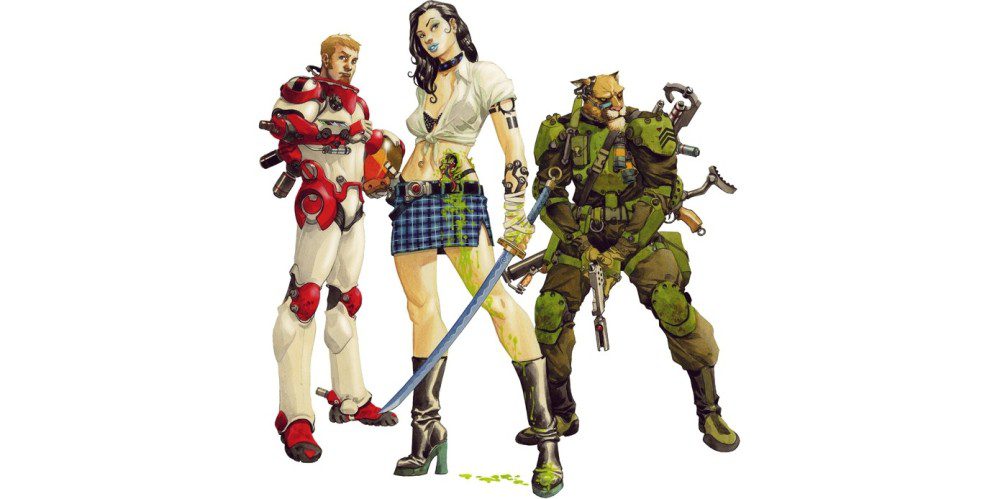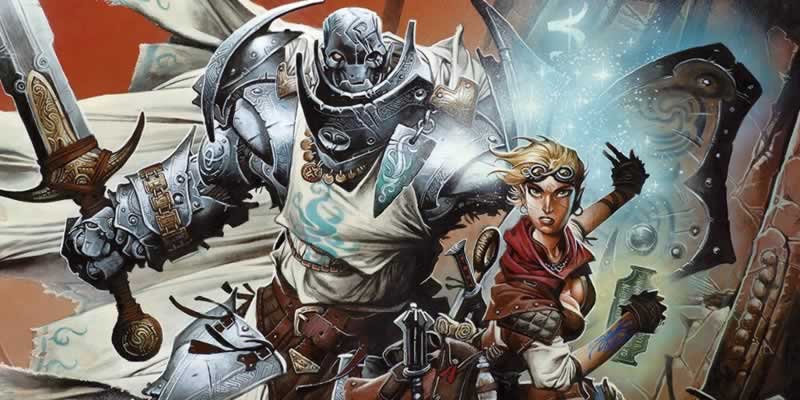Splitting the Party

Rich Burlew isn't stressed by splitting the party, you shouldn't be either.
Last week I mentioned how Kat Kuhl from the One Shot Campaign podcast handles their party splitting, or when a PC is unconscious. I recently read several conversations on party splitting across my feeds that sounded something like this:
“How do you handle nights when your party is splitting up to accomplish personal interests? Two players have business in one part of the city, another has a profession they are working on and a couple others have NPCs they want to visit. I feel like I am doing an OK job of giving everyone their own turn but, I’m curious how other GMs might handle this?”
Every GM runs into this at one point or another. Some GMs feel comfortable jumping from group to group, keeping the action moving, skipping die rolls and “going cinematic” in non-combat scenes, or running two fights on two different maps as if they’re in the same room. Not every GM has honed those skills, and those who have don’t always have the energy.
If you’re party wants to split up, don’t stress. Let the players do the work for you.
Pre-planned Splitting
If you’re lucky enough to see this a game ahead, jot down a few notes about the NPCs’ personalities, attitudes, and answers to key questions the PCs are likely to ask. Keep the notes short, no more than one or two quick sentences on personality and a couple bullet-points on answers. Then let the NPC player off the leash to answer non-plot-related questions however they like. Mediate any plot-related questions as you see fit, but try to let the player ad-lib as much as possible. Some of the best story elements will come from your players thinking out lout at the table. Let them.
John Jingleheimerschmidt
Disheveled fence for the local thieves’ guild. Reliable reputation, wired on cacao-leaves, speaks in short, choppy sentences.
- Has a buyer for the Gem of Hubris
- Demand 20% commission
- Players must give him the gem, buyer will not make contact directly with PCs
- If they insist, John will inform buyer, but don’t get their hopes up
- Will offer Gimlison information on his father for no less than 50gp; Haggle hard
- Father is in Hellscape Prison
What does disheveled mean in this case? Is he dressed like a homeless person? Is he finely dressed but haggard from stress? Is he normally clean-cut but was late to the meet due to a barfight? Who cares?! Let the player run with it.
On the Spot Splitting
If your players want to split up in the middle of a session to shop, meet with NPCs, or other non-combat related things, take the non-involved players aside (make sure this is no more than a 30-60 seconds): “Jim, you’re a surly old human merchant who hates dwarves and will jack up prices on them; say, 10-20% over list. Sue, you’re the merchant’s daughter who will do anything to piss off her father. Make up your own names.” When you get back to the table and your other players–say, an elf and a dwarf–go shopping, hilarity ensues (and you can grab a sandwich while you watch the fun).
Downtime in Combat
Player unconscious or dead in the middle of a fight? Quickly write down the AC, HP, move, attack bonus, and damage of one of your monsters on a 3×5 card and have the player take over. Write only these stats down. This could be for one ogre or 10 orcs. Don’t worry about skill bonuses and other sundries unless they come up. For example, only tell the monster-player their Perception bonus if a PC is trying to sneak up on them, or their Dexterity save if a fireball gets thrown. Monster has a special attack? Just write Breath Weapon on the card. When the monster-player wants to use it, give him the stats.
Keep it simple and fast.
Hobgoblins: 30′; AC 16; +5 (longsword or longbow: 1d8+3); HP: 10 each
Tactics: Advantage on attacks if at least one ally within 5 ft of a target.
Adv. Hellhound: 40′; AC 18; +7 (bite, 1d8+3+1d6 fire); HP: 24 each
Breath Weapon; Immune: Fire; Vulnerable: Cold
Split Party Combats
| A unit of allied elven archers help the PCs while buildings burn in the background. |
The downtime technique works just as well if one or more groups run into combat. Say your ranger and rogue want to scout the passageway ahead, while the wizard, cleric, and fighter barricade a previously explored room to rest in. The scouts stumble into a slide trap that dumps them into an otyugh’s trash pit. You have three players not doing anything, while the other two fight.
You could say that the others appear immediately; easy, but a strained solution and not very dramatic. Instead, jot down the stats for a few low-CR monsters that seem likely, skeletons or dire rats in this case, then have the players jump in to pound on their teammates. Depending on the level of your players, a few extra low-CR monsters won’t turn a fight into a TPK. After the skeletons are destroyed, the ranger and rogue are hurting, or the appropriate number of rounds go by, have the players’ real characters show up in the proverbial nick-of-time.
NPC Allies
During Red Hand of Doom, my PCs made allies of dwarves, humans, and swamp elves who agreed to help defend a city being attacked by a monstrous horde. Instead of just saying “your allies help out around town,” I gave the players control of one human, one dwarf, and one elf unit at their location (see stat sheet below). Excessive rolls were cut down by having each NPC go down after one hit (4th edition minion rules), by replacing damage dice with straight damage, and by having the elf unit either fire at one target or make a single Area of Effect attack against a group.
Any player could command a unit by using their own actions to grant the unit actions (a bonus action and/or regular action could be used to give the unit any one of the three actions listed in the stat sheet) If no one gave a unit an order, I briefly described how the NPCs took down extra attackers who weren’t on the board–“A bugbear snuck through the buildings to flank you, but the human pikemen pin it against a wall, letting the elven archers riddle it with arrows.”
This approach gave the players the feeling that their previous actions had tangible results and made combat interesting without slowing it down.
| Dwarven mercenaries and human pikemen help defend the barricade against a rampaging giant. |
The Most Important Thing
If you walk away with only one thing from this post, it’s this: Keep the Action Moving.
Here are a few tips and tricks
- Pausing to make rolls the player’s don’t understand or to look up rules can kill the momentum of any session. Whether the party is split or not, ask players who aren’t involved in the current action to make minor rolls, pick random numbers, and write down notes for you while you’re narrating.
- If you use gaming aids like Critical Hit or Critical Fumble decks, have the players draw the cards for themselves and the monsters. They’ll love to gloat at a brutal monster fumble and hang their head when they draw the monster’s criticals.
- If there’s a rules question, make a judgement immediately and apply it to everyone until the fight, or even the entire game session, is over. Look up the rule afterward and apply it from then on. You’ll give your rules-lawyers a fit, but hand them a piece of pizza, kindly suggest they run their own game, and move on.
- Instead of having the party roll skill checks during stress-free situations, simply assume they “Take 10”. If the player with a +8 Perception is talking to an NPC in a secure courtyard when a ninja attacks, roll the ninja’s Stealth against an 18 Passive Perception. If the ninja beats an 18, you don’t have to limit yourself you “you don’t see the ninja kill the NPC”, you can tell the player that they see the ninja’s attack, but give them a few simple choices: step in front of the blow (automatic hit on PC instead of NPC), push the NPC to the ground (could have serious social consequences but attack is made at Disadvantage), or let the NPC get hit but allow a followup strike with Advantage. Stress the anxiety by giving them a healthy 5 seconds to decide*.
- To keep things moving in combat I announce the upcoming turns like an event at a high school track meet:“Gimli’s up; Legolas is on deck; Goblins are in the hole.”This prevents players from being surprised when it’s their turn and gives them extra time to think.
- Have player’s roll all attacks and damage dice at the same time whenever possible. If they miss, no harm. If they hit, damage is ready to go. GMs should do the same.
- Combats are fast and brutal. To quote Nick Fury, “Have you ever been in a firefight? Did you feel an overabundance of control?” Give your players an appropriate amount of time to think about their moves (especially with new players), but if they’re slowing down the action offer up a 5-10 second heads up* before assuming they’ve delayed their action until later in the round. Do NOT make them lose their turn. You will suck an entire night’s fun out of a player by punishing them for trying to make the best move to help the group. Delaying allows them to take their full action anytime after the next player and is a reasonable reflection of combat chaos.
* = Though I give two examples of “timers” in this blog, pressuring your players with countdowns should be used sparingly, at best. Don’t count out loud. Don’t sing the Jeopardy jingle. Don’t hover. Calmly say, “I’m giving you about 5 seconds to make a final decision, then you’re free to go after the next person,” or “Here are your choices. Any questions? Cool. I’ll give you a few seconds before I roll the ninja’s damage.”
Red Hand of Doom NPC Units: Attack on Brindol
5th edition rules (formerly 4th)
A PC can use their action or a bonus action to grant a unit one or more of the actions listed. A PC may grant a single unit a single Move action for free. For example, a PC wizard is being attacked by an ogre that broke through the party’s defense. Instead of casting his spells, he moves two unengaged human pikemen adjacent to him (granting him an AC bonus) as a free action, uses his action to have the pikeman attack the ogre. When the pikeman successfully hits the ogre, the wizard uses a bonus action to have the pikeman attempt to shove the ogre back 5 ft. If the first pikeman didn’t hit, the wizard could use his bonus action to have the second pikeman attack, but couldn’t trigger the shove unless he somehow had an additional action.
Unit of 6 Swamp Elf archer minions
AC: 16; HP: Minion (if they take 1hp from a non-area attack, elf dies. If they fail a save against an area damage spell, elf dies.)
Move 35, ignore Difficult Terrain
Rain of Arrows: Range 100 ft., +8 to hit, 30 piercing dmg 1 target, or 10 piercing dmg to all targets in a 10 ft. square. (15 dmg to 1 target, or 5 dmg to area after 3 elves are killed)
Action: entire unit makes either single target or area attack
Move: Unit moves as ordering PC wishes
Bonus: Target(s) speed reduced by 10 ft. until the end of their next turn if attack is successful.
Unit of 5 Human Pikemen minions
AC: 18; HP: Minion (if they take 1hp from a non-area attack, pikeman dies. If they fail a save against an area damage spell, pikeman dies.)
Move 25 ft., able to flank and make Opportunity Attacks
Allies gain +2 shield bonus to AC and Dexterity saving throws if one or more pikemen are adjacent to them.
Pike: Reach, +6 to hit, 10 piercing dmg
Action: One human pikeman attacks an enemy in range
Move: Unit moves as ordering PC wishes
Bonus: Shove target of a successful attack 5ft on failed DC 12 Strength save.
Unit of 5 Dwarf mercenary minions
AC: 17, HP: Minion (if they take 1hp from a non-area attack, dwarf dies. If they fail a save against an area damage spell, dwarf dies.)
Move 25 ft., able to flank and make Opportunity Attacks
Axe/Hammer: +7 to hit, 10 slashing or bludgeoning dmg
Action: One dwarf mercenary attacks an adjacent enemy
Move: Unit moves as ordering PC wishes
Reaction: If a dwarf dies, any PC may use their reaction to have the dwarf survive instead. Each dwarf mercenary may only benefit from this ability once per long rest.



